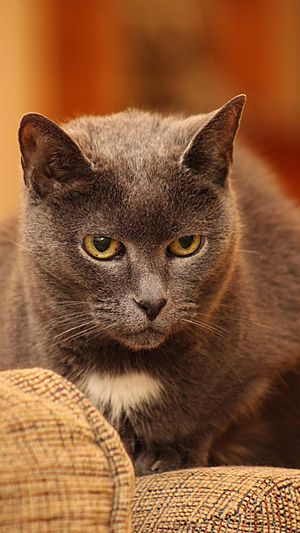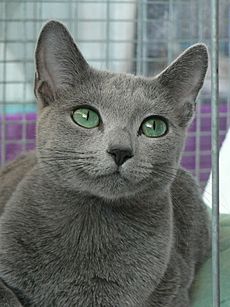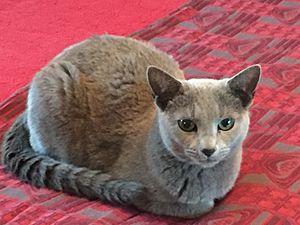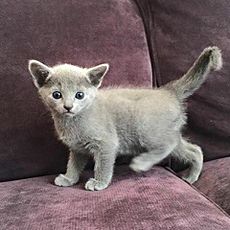Russian Blue facts for kids
Quick facts for kids Russian Blue |
|
|---|---|
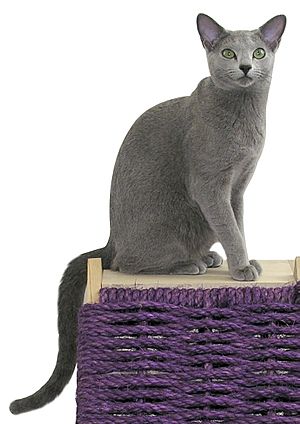
1 year old Siamese/Russian blue male (American style)
|
|
| Other names | Archangel Blue, Archangel Cat |
| Origin | |
| Breed standards | |
| CFA | standard |
| FIFe | standard |
| TICA | standard |
| ACF | standard |
| ACFA/CAA | standard |
| CCA-AFC | standard |
| GCCF | standard |
| Notes | |
|
The ACF and GCCF also recognize Russian Blues in white and black, however the CFA does not. In addition, ACFA recognizes Russian Shorthairs in white, black, and blue.
|
|
| Domestic cat (Felis catus) | |
The Russian Blue cat is a beautiful cat breed known for its unique blue-gray fur. This cat's coat can range from a light, shiny silver to a darker, slate gray. Its short, thick fur stands out from its body, making it feel very soft and plush. This special coat has been a key feature of the breed for over 100 years.
Contents
Where Russian Blues Come From
The Russian Blue is a natural breed of cat. This means it developed on its own, without much help from people. Many believe these cats first came from the port city of Arkhangelsk in Russia. This is why they are sometimes called Archangel Blues.
Sailors likely brought these cats from the Archangel Isles to Great Britain and Northern Europe in the 1860s. The first time an "Archangel Cat" was mentioned in British writing was in 1862. The first time one was shown in a cat show was in 1872. This happened at The Crystal Palace in England.
At first, Russian Blues competed in shows with all other blue cats. But in 1912, they got their own special category. The breed was mostly developed in England and Scandinavia until after World War II.
How the Breed Developed
After World War II, there weren't many Russian Blue cats left. So, breeders started to cross-breed them with Siamese cats. This helped increase their numbers. Even though Russian Blues were in the United States before the war, American breeders created the modern Russian Blue we see today after the war. They mixed the cat types from Scandinavia and Britain.
Today, most of the Siamese traits have been bred out. However, the short, blue-gray fur is common in many mixed-breed cats. This can sometimes make it hard to tell a purebred Russian Blue from a mixed one.
Russian Blues have a soft, short coat that is a pale blue-gray color. They have bright emerald green eyes. Their outer hairs have silver tips, which makes their fur look shiny. This breed has also been used to help create other cat breeds. For example, they helped develop the Havana Brown and change the Nebelung breed.
Some Russian White and Russian Black cats were created by mixing Russian Blues with domestic white cats. These white cats were thought to have come from Russia. These new colors were accepted by cat lovers in Australia and South Africa in the late 1970s. They are now also accepted in the United Kingdom. However, some large cat groups, like the Cat Fanciers' Association, only recognize the blue color for Russian Blues.
What Russian Blues Look Like
The Russian Blue has bright green eyes. Their paw pads are a pinkish-purple color. They have a special "double coat" of fur. This means they have two layers of short, thick fur. The color of their fur is a bluish-gray. This color is a lighter version of black fur.
Sometimes, if Russian Blues are bred with cats that carry certain genes (from their Siamese ancestors), they can have kittens with different colors. These kittens might be solid blue or white with blue points, like a Siamese cat. Most cat registries do not allow these "color-point" Russian Blues to be shown or bred.
Their Unique Coat
The Russian Blue's coat is very special. The soft, fluffy undercoat is the same length as the outer guard hairs. These guard hairs are a solid blue color with silver tips. This gives the coat a shimmering, shiny look. The fur is very thick, plush, and soft to touch. It feels even softer than silk!
Their eyes are almost always a dark, bright green. If a Russian Blue has white patches of fur or yellow eyes when it's an adult, these are seen as flaws for show cats. It's important not to confuse Russian Blues with British Blues. British Blues are not a separate breed; they are just British Shorthair cats that happen to have blue fur. Russian Blues are also different from Chartreux or Korat cats, which are other natural blue cat breeds.
Russian Blue Personality
Russian Blues are usually quiet cats, but there are always exceptions! They can be a bit shy around strangers. However, if they grow up in a busy home, they can be more outgoing. Many Russian Blues have even been taught to do tricks.
They are also very good hunters. They often catch small animals like rodents, birds, or rabbits. Russian Blues are loving and easygoing with their families. But they don't like big changes and prefer a regular, predictable schedule.
Playful and Smart
Russian Blue kittens are full of energy. They need plenty of playmates or toys. If they get bored, they can become a bit mischievous! They are also very athletic. They can jump and climb almost as well as Abyssinian cats.
Russian Blues take a while to grow up. They keep many of their kitten-like traits until they are 3 or 4 years old. Even older Russian Blues love to play with their owners. They are also very smart cats. They have an excellent memory. They will remember where their favorite toys are hidden and lead you to them when they want to play. They also remember people they like. They will rush to greet familiar visitors, even if it's been a long time since they last saw them.
Growth and Life Cycle
Russian Blues usually live for about 10 to 20 years. Some have even lived to be 25 years old! They tend to be very healthy cats. They don't usually have many genetic health problems and are not often sick.
They are small to medium-sized cats. When they are fully grown, they usually weigh about 3.6 to 6.8 kg (8 to 15 lb). Male cats are typically larger than females. A female Russian Blue's gestation period (how long she is pregnant) is about 64 days.
Allergies and Russian Blues
Some people believe that Russian Blues might be easier for people with mild cat allergies to be around. It's thought that Russian Blues produce less of a certain protein called glycoprotein Fel d 1. This protein is a common cause of cat allergies.
Also, their thick coat might trap more of the allergens close to the cat's skin. This doesn't mean you won't have any allergies at all. But for some people, the reaction might be much less severe and last for a shorter time compared to other cat breeds. Because of this, Russian Blues are very popular with people who have allergies around the world.
See also
 In Spanish: Azul ruso para niños
In Spanish: Azul ruso para niños
- Nebelung, a cat breed with longer hair that used the Russian Blue in its development
- Russian White, Black, and Tabby


